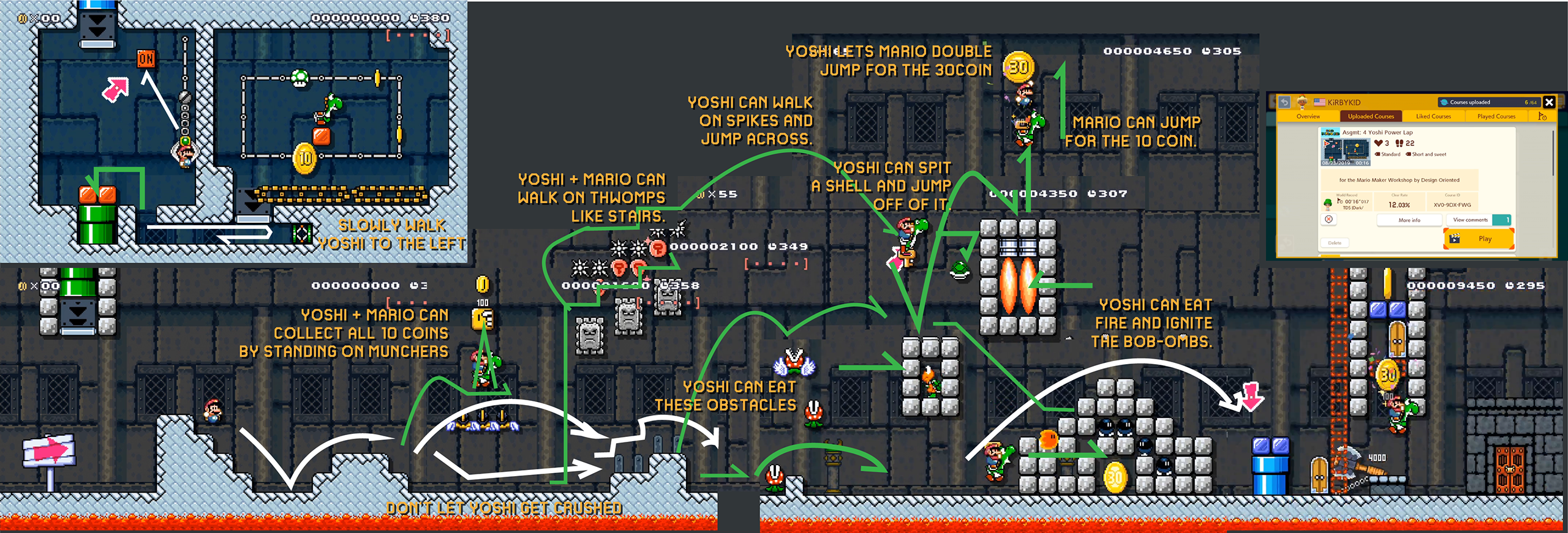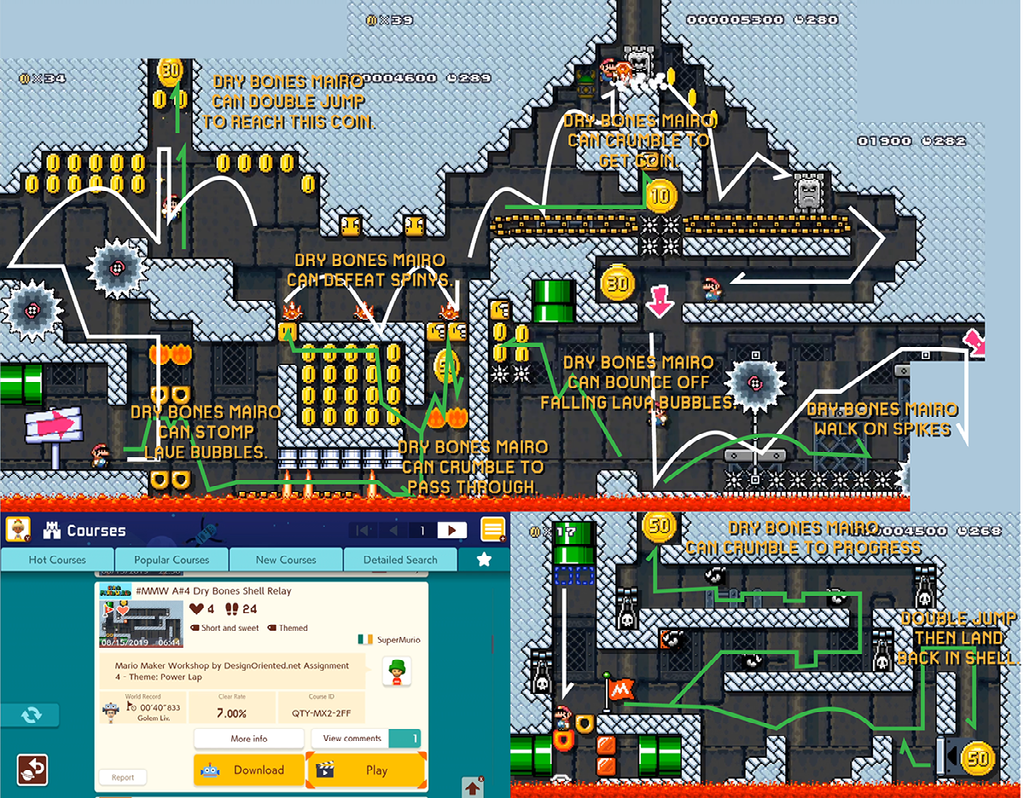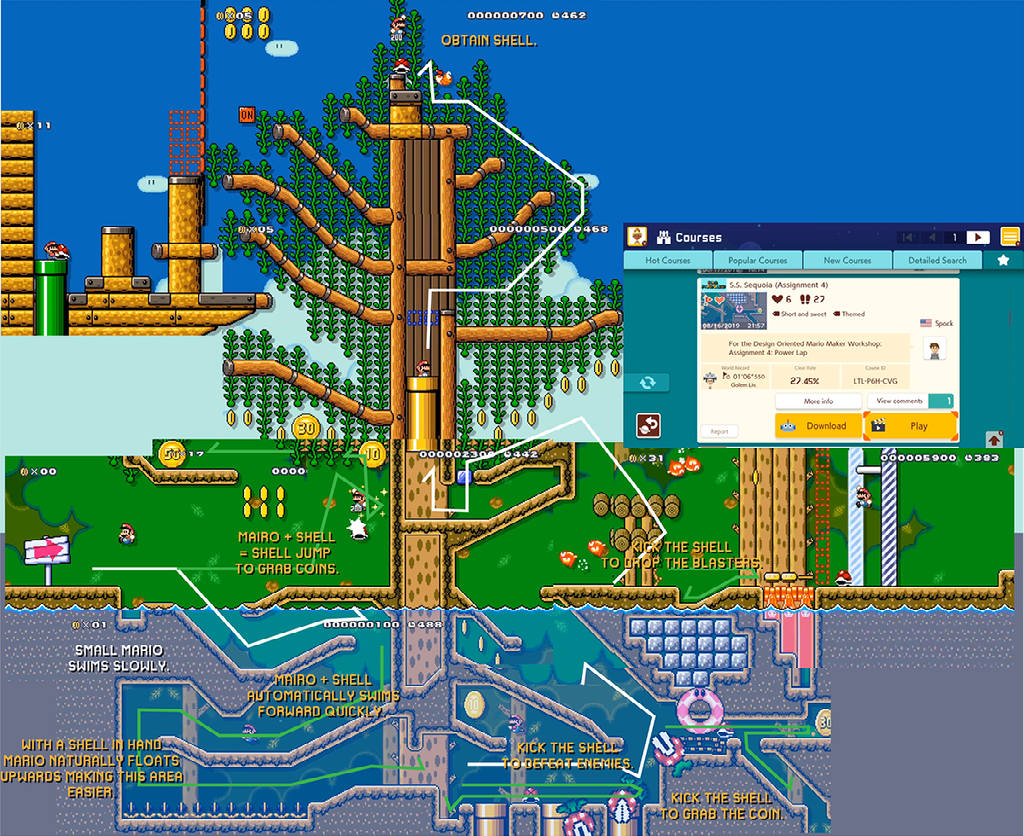Lesson 5: Powered-up
The core of Mario's level design consist of expertly designed layouts, coins, and enemies. In Lesson 4 the Workshop created enemy gauntlets to collectively explore the vast design space of enemy encounter possibilities. But there's on more element to consider. The final element of core Mario level design elements is power-ups.
Everyone who has played Mario platformers is familiar with power-ups. Players seek them and hold on to them as long as possible to increase their chances of success. Though each may only augment Mario's abilities a little, each power-up is more complex than the average enemy.
We start thinking about power-ups in terms of functionality... the Bee Suit and Boo Suit [added]... the ability to temporarily escape from the law of gravity through floatation. ~ Yoshiaki Koizumi
Power-ups, by their very nature, are designed to give the player power. With this power, the player can undermine the challenges in a course to make things easier. They can also make things harder or more interesting. Understanding and designing around this power shift adds a layer of complexity to consider...
Power-up Considerations...
- Does the power-up give the player a useful ability?
- Does the player earn the power-up?
- Is the power gained balance with the difficulty of obtaining the power-up?
- Is the course designed around Small Mario, powered-up Mario, or both?
- Is the power-up required for progression or secrets?
- Is there a reliable way for players to obtain power-ups?
- Are there parts of a course that are restricted from powered-up Mario?
- Is the course interesting with and without the power-up?
- Is the power-up too powerful (so strong it makes the level mindlessly easy and not fun)?
- Is there more than one power-up accessible in the course?
If it is starting to sound like properly designing a course around power-ups essentially requires the Maker to design two courses simultaneously, good. Now you understand why layered level design is inherently more difficult. Each of the core elements of Mario's level design that are added on top of the basic layout (coins, enemies, power-ups) each have their own design principles and can convey unique design ideas. In a way, making a standard Mario course requires designing 3 courses in one! This fundamental approach to level design is what gives Nintendo-made Mario courses their depth.
Assignment#4: Design Power-up Courses 2 layers
For Assignment #4 Power Lap, we identified 6 distinct aspects of designing courses around power-ups:
- Obtaining: Is there anything unique about obtaining the power-up? Does it move or require specific steps to obtain?
- Movement: How does the power-up change the way Mario can safely move around?
- Offense: How does the power-up change the way Mario combats enemies?
- Defense: How does the power-up allow Mario to defend or evade dangerous situations?
- Ability: Does the power-up give Mario new mechanics (an ability or attack)?
- Properties: Does the power-up give Mario new properties to his existing mechanics?
To help minimize the diffculty of assignment 4, we encouraged Workshoppers to keep it simple. The goal was to focus on designing compact courses specifically to accomplish the tasks of showcasing the 6 aspects described above. By doing so, Workshoppers gained the important skill of "designing to spec." We're learning not to get distracted by elaborate, unique, nuanced, or crazy ideas.
Compared to our Enemy Gauntlets, our Power Lap courses were much less difficult and less frustrating. Before when we focused our designs on difficulty (a notion that comes naturally when focusing on enemy elements) the gameplay ideas and course challenges were very narrow in focus. This narrow focus resulted in linear challenges requiring tight, precise platforming. It's as if the designer found a single possibility and forced the player to find it too. "Forced" is not "free" and often times not fun either.
When designing around a power-up, designers naturally think about the contrast between playing normally and playing with power. This means the designer is focused on designing a course for ordinary platforming in addition to extra-ordinary powered-up play. Having the power-up isn't forced; it's earned and optional. The result is a collection of courses that are complex, deep, layered, interesting, challenging, nuanced, and above all else accessible, clear, and fun. Using proper design and clear principles is a much more effective way to create challenge and convey complex gameplay ideas while teaching the player naturally.
That's how we moved forward with development, always racking our brains trying to figure out what to do with Mario next. We were always thinking about what would be fun for gamers and fun for us to make ~Konno
The complexity and layered density of our courses is increasing. It was a blast to play all 16 of our courses. So fun, in fact, that I took the extra time to create level maps with notes. Enjoy!















